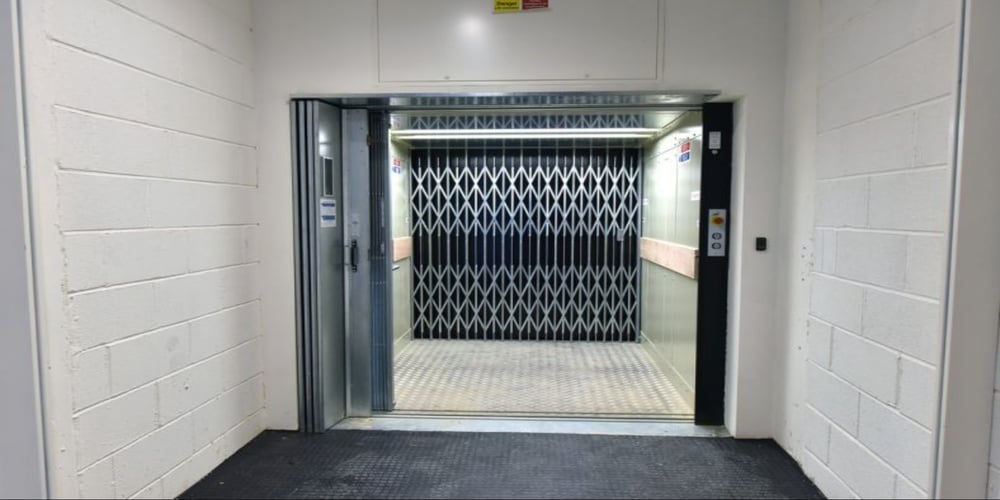Bike & Bin Lifts: Lifts for Waste Management & Bike Transportation

There is an increasing trend of lifts being used to aid underground storage of bikes/bins in commercial and residential projects. In this short blog post, we outline the considerations for these types of applications and the most suitable bin lift systems to choose from.
Goods lifts are fast becoming a popular choice for Architects when planning movements within buildings and external areas, helping to enable underground bin stores in both commercial and residential projects and bike stores in residential developments.
The benefits of a bin/bike lift
For any lift the benefits are obvious - the lift platform can be virtually the same size as the load and in some applications, an attendant can also travel in the lift. Placing bike or bin storage underground helps with security and/or hiding unsightly yet necessary bins from view, offering immediate improvement in the visual environment and an increase in usable ground-level space.
Some less obvious but equally important benefits of underground bins are the measurable reduction in littering and vandalism and less foul odour due to cool year-round subterranean temperatures.
All manner of goods can be transported between levels easily, safely and effortlessly – wheelie bins, 360-litre bins, Euro bins, bikes (and bike owner) can be transported vertically.
Steps and stairways need not be a problem. A split-level lift can eliminate any ramp and the large amounts of space they require, whilst also avoiding any dangers of the bin or bike moving on it's own.
In built-up areas and conurbations where space is at a premium, it makes sense to place bike storage areas and combined refuse areas underground. Various sizes of bin lifts or bike lifts are available with the most popular intended to accommodate two or three residential wheelie bins. Larger units are designed for apartment buildings and commercial use.
Lift considerations in such applications
Most councils provide guidelines on waste management and the requirements for collection. Specifiers should ensure that businesses and waste contractors are able to meet these requirements through the design of waste storage and collection facilities for any new developments, including storage space within the business premises. Whilst not all Local Council guidelines state the requirements for a bin lift to feature in their waste management plans, some do outline the following recommendations for larger commercial and residential applications:
- The goods lift must be large enough to accommodate a person as well as at least one waste container.
- In large schemes, more than one waste container will need to be accommodated.
- The lift doors and adjacent lobby or corridor must be sized so that waste containers can be easily manoeuvred.
- Where lifts are provided for the use of cyclists these should be sufficiently large to accommodate their cycles.
Lift specification for waste management
Here at Stannah we would always recommend including the following to any bin hoist or bike lift specification:
- Bump rails - as they provide crucial in car protection.
- Robust finishes to lift car walls.
- Communication device if an attendant is travelling in the lift.
What type of lift do we recommend for these applications?
Our Goodsmaster CD Plus (which can take up to two lift attendants) and Goodsmaster CD range (goods-only lifts) are the most popular in waste management due to their size and capacity options. Whilst most regulations recommend an accompanied goods lift, it may be the preferred option to send the large waste bins unaccompanied, as there may be limited space within the car for attendants. Finally our Levelmaster can provide a tailored solution for shorter travel requirements.
For bike lifts, where the owner accompanies the bike, we would recommended our Goodsmaster CD Plus or for larger applications our bespoke Goodsmaster HD range or a passenger lift also suitable for goods. Sometimes a separate goods lift for larger waste management rather than sharing passenger/goods lift, is required. This could be because the bins may require a larger capacity, or that it is hygienically better to do so.
If you are interested in a goods lift for waste management and/or bike transportation, take a look at our product range:
/commerical-building-SMALL.jpeg?width=250&name=commerical-building-SMALL.jpeg) Or why not take a look at our case study where Stannah supplied and installed a through-car goods attendant lift in commercial offices in London.
Or why not take a look at our case study where Stannah supplied and installed a through-car goods attendant lift in commercial offices in London.
This lift moves bicycles and a 1100 litre wheelie bin between the ground floor and the basement storage facility in this extensively reconfigured and refurbished building.
Looking to incorporate a lift into your project?
To enable easy specification and see if a lift can fit in your project why not visit our technical area, where there's a wealth of product information, specifications, CAD blocks and more.
How can we help?
Whatever the lift requirement, we can be certain that the pressure for more housing will increase with our population and the solution found vertically, increasing the requirement for lifts. We will continue to meet the needs for accessibility for everyone in the entire built environment, with housing at the forefront of our market areas.
We work in both private and public housing, forming strong relationships with leading contractors for design and build tenders, working with architects and clients in traditional procurement routes, and liaising directly with Housing Associations to provide lifts based on the needs of the tenants.
Who knows what the future will bring, for business, for homeowners and for housing managers, Why not find out more about the work we do within the housing sector?
FIND OUT MORE ABOUT THE HOUSING SECTOR
Or alternatively why not contact us to discuss your requirements – we know we can help
With over 50,000 installations across the UK and nearly 100,000 units in our service portfolio, we offer a wide range of lift solutions and services to move people and goods. Take a look at our product range or simply get in touch.
Contact Us

